As Tabitha Boonstra showed the children of La Esperanza in Honduras their picture on her digital camera, she could not believe their reaction.
‘They would come running up to you from wherever they were, and they’d be yelling ‘photo, photo!’ They’d stand there, and you would take their picture, then you’d show them on the back of the digital camera. They would be the happiest kids in the world’.
‘It was such a simple thing, yet it made them so happy’ she says guessing that there aren’t too many mirrors in rural Honduras. It was moments like this, and many others that made volunteering such a memorable experience for Tabitha of Ontario, Canada.
She spent three months helping to build houses and provide aid with sanitation projects in rural Honduras through the Global Volunteer Network (GVN), an organization that helps connect volunteers with communities in need. She had previously volunteered within her own community, working with children and people with special needs, but never anything like this.
‘I wanted to do something different’ she says, ‘and volunteering is a good way to go and learn a different culture’.
Tabitha really enjoyed volunteering, getting amongst the action, and using the opportunity to really make a difference to the lives of the people in Honduras.
‘I built houses for the indigenous people using trees, mud and adobe bricks. I feel the living conditions of the people are greatly improved by this effort as less people are crammed into tiny houses and they have less draughty houses with better seals against animals and bugs. Some even got concrete floors put in, which greatly reduces health problems. The work was rewarding and seemed to make a big difference’ says Tabitha.
Rural poverty in Honduras is among the most severe in Latin America. Approximately 53% of the population is rural, and it is estimated that 75% of the rural population lives below the poverty line, unable to meet basic needs. The country still has high rates of population growth, infant mortality, child malnutrition and illiteracy. Access to simple healthcare and sanitation is lacking, and it is estimated that over 30 percent of child deaths in Honduras are caused by a common and preventable digestive sickness.
On top of all of this, Honduras was hit severely by Hurricane Mitch in 1998, and the results were devastating. At least 5,000 people were killed and 70% of the country’s crops were destroyed. This has put more pressure on the already struggling economy, and has been a huge setback to development.
The Honduras building program helps foreign volunteers assist families to build or improve their homes and schools, with work including renovation, making bricks, building walls, painting and building wooden playgrounds for the local children. There are also sanitation programs in place, in order to implement basic plumbing, and to help educate the local children about health and wellbeing.
As there are very few tools, the volunteers do mainly manual work. Because they are often working with mud bricks, they can get pretty dirty, but it is lots of fun, and a great learning experience. You also need to be prepared to use your initiative in Honduras, as Tabitha found out.
‘Because you are a foreigner, they treated you in such a manner, that they felt you were above them. If you wanted to work, you had to pick up a shovel and say ‘give me something to do’, she says.
But once you do get amongst it, the people are very grateful for the assistance the volunteers give. It really has a positive effect on a community to know that a volunteer has given up time, money and comfort to help them.
‘It’s just natural for them to think that foreigners don’t care about third word countries or people who have a poor life. But when they see volunteers, they realize that some people in the world, no matter how rich they are or what their status, they do care about others, and that people are willing to help’, says Tabitha.
The program is not all hard work though, and there is lots of time to get to know your host family, or to explore the country and mingle with the locals. Tabitha loved being around the local children, and took any chance she could get to hang out with them.
‘Playing soccer with the kids was definitely the most fun. There are wide open spaces everywhere and you are playing on a dirt road. If you would kick a ball too far, it would go way down this mountainous hill, and all the kids would run down to go get it for you, clambering down it. They were so eager to help you out’. The memory of their smiling faces will be something that will stay with Tabitha for a long time.
Building in Honduras enables volunteers from more developed countries to use their skills and enthusiasm to assist in providing these people with a better life. Tabitha believes that the organization really does make a difference, and it is because of the volunteers that this happens.
‘I do feel like I have helped, because we built the houses. These people now have safer shelters and a more sanitary place to live in’.
Volunteering in a foreign country is such a unique experience, and quite different from being a tourist. Not only does the community benefit, but the volunteer also gets an opportunity of a lifetime.
‘You actually get to hang out with the locals, get to know them, become friends with them, and get an idea of what life is like there. When you travel you get to see the scenery and eat the food, but you don’t experience what life is actually like in that country’.
‘I could have just travelled for four months and maybe seen some cool things, but not bettered myself or anyone else. Because I volunteered with my time, it helped other people too, and I think that is just a great thing’.
If you are interested in volunteering, visit the GVN website at www.volunteer.org.nz

 Public transport, or rather the lack of it lets Brunei down. There are buses, but the network is not extensive and they tend to stop at 5pm, so hiring a car is something of a pre-requisite.
Public transport, or rather the lack of it lets Brunei down. There are buses, but the network is not extensive and they tend to stop at 5pm, so hiring a car is something of a pre-requisite. by a boatman who lives there that around 20,000 people live in the Kampong and more and more are leaving for more comfortable housing. I say up market, because it has electricity, satellite dishes and some of the houses have two storeys and pretty painted verandas and large
by a boatman who lives there that around 20,000 people live in the Kampong and more and more are leaving for more comfortable housing. I say up market, because it has electricity, satellite dishes and some of the houses have two storeys and pretty painted verandas and large 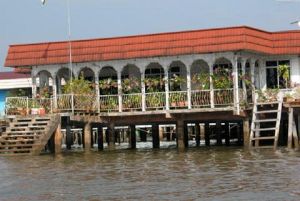 pots of flowers and other plants. There are also several primary and secondary schools, a mosque and a fire station and a floating Shell petrol station. On my last trip there, I was told that the govt has plans to demolish some of the houses to build a bridge but it is still in the planning stage and attracting much controversy. The inhabitants are planned to be moved to the less characterful single storey concrete houses on stills at the lower end of the Kampong. It’s a little strange to see people’s cars parked on the opposite side of
pots of flowers and other plants. There are also several primary and secondary schools, a mosque and a fire station and a floating Shell petrol station. On my last trip there, I was told that the govt has plans to demolish some of the houses to build a bridge but it is still in the planning stage and attracting much controversy. The inhabitants are planned to be moved to the less characterful single storey concrete houses on stills at the lower end of the Kampong. It’s a little strange to see people’s cars parked on the opposite side of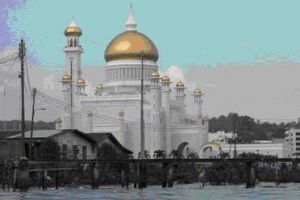 the Kampong – there are loads, and another reason why I say it’s not quite like similar Kampong’s I’ve seen. You should expect to pay about between 15 – 20 Brunei dollars for an hour’s tour of the Kampong. Further upstream you can see proboscis monkeys in the morning and late afternoon, but the usual boatmen will not usually take you there, you may find you have to book a tour (not cheap at 60 Brunei dollars).
the Kampong – there are loads, and another reason why I say it’s not quite like similar Kampong’s I’ve seen. You should expect to pay about between 15 – 20 Brunei dollars for an hour’s tour of the Kampong. Further upstream you can see proboscis monkeys in the morning and late afternoon, but the usual boatmen will not usually take you there, you may find you have to book a tour (not cheap at 60 Brunei dollars).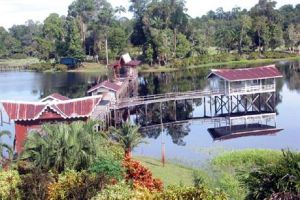 Tasek Merimbun, also known as Merimbun Heritage Park, is 27km (17miles) inland from Tutong, and contains Brunei’s largest lake with a tumbled down and decidedly precarious wooden walkway that used to take you all the way out over the lake and across to the island in the middle. It used to be a pretty place surrounded by forest with several walking trails. You can tell that it used to be very pretty but it has a somewhat dilapidated air about it these days.
Tasek Merimbun, also known as Merimbun Heritage Park, is 27km (17miles) inland from Tutong, and contains Brunei’s largest lake with a tumbled down and decidedly precarious wooden walkway that used to take you all the way out over the lake and across to the island in the middle. It used to be a pretty place surrounded by forest with several walking trails. You can tell that it used to be very pretty but it has a somewhat dilapidated air about it these days. 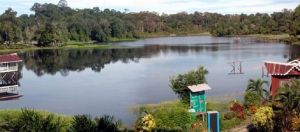
 It commemorates the production of billionth barrel of oil by the Seria oilfield which can be seen very close to the shore.
It commemorates the production of billionth barrel of oil by the Seria oilfield which can be seen very close to the shore. 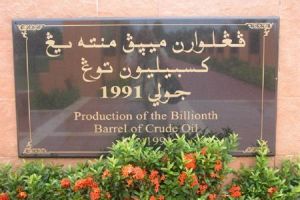 expats, it was around this time that various foreign workers responsible for maintaining the amusement ground left the country, so some local people laughingly joke that the rides are not quite as safe as they once were. When the Beetle went, most rides were available and she had great fun on the large roller coaster (there are two or three) and especially the log flume which does a crazy reverse at the top of a peak and whooshes down backwards (amidst much embarrassing Beetle squeaks). The
expats, it was around this time that various foreign workers responsible for maintaining the amusement ground left the country, so some local people laughingly joke that the rides are not quite as safe as they once were. When the Beetle went, most rides were available and she had great fun on the large roller coaster (there are two or three) and especially the log flume which does a crazy reverse at the top of a peak and whooshes down backwards (amidst much embarrassing Beetle squeaks). The 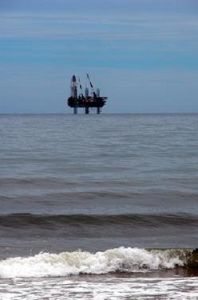 second time the Beetle visited, many rides were shut down for maintenance, but it’s still a fun and occasionally spooky place to visit (where there is no lighting because the rides are closed) for an evening out. Now many rides languish, waiting for spare parts or to be re-insured but it’s still an intriguing experience to wander round
the massive semi-deserted grounds in the evening.
second time the Beetle visited, many rides were shut down for maintenance, but it’s still a fun and occasionally spooky place to visit (where there is no lighting because the rides are closed) for an evening out. Now many rides languish, waiting for spare parts or to be re-insured but it’s still an intriguing experience to wander round
the massive semi-deserted grounds in the evening.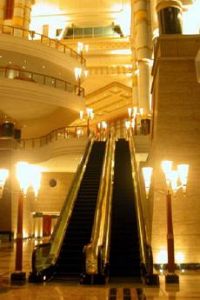 commissioned by the Sultan’s brother, Prince Jefri. This amazingly luxurious
commissioned by the Sultan’s brother, Prince Jefri. This amazingly luxurious 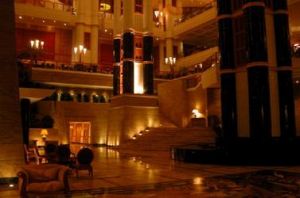 Empire Hotel which inside resembles a pastiche of all the different styles you possibly imagine, from 1920s art deco to the Harrods-like Egyptian and Greek columns is very impressive and a tourist sight in its own right – an absolute must in all its gaudy glory. There are several restaurants and buffets to sample and there is a small beach and pools as part of the grounds. Definitely worth a visit and occasionally, because of very low occupancy rates, good rates are to be had to stay in the hotel.
Empire Hotel which inside resembles a pastiche of all the different styles you possibly imagine, from 1920s art deco to the Harrods-like Egyptian and Greek columns is very impressive and a tourist sight in its own right – an absolute must in all its gaudy glory. There are several restaurants and buffets to sample and there is a small beach and pools as part of the grounds. Definitely worth a visit and occasionally, because of very low occupancy rates, good rates are to be had to stay in the hotel.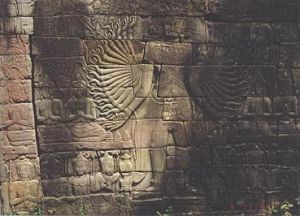 Never fully excavated and inaccessible for decades due to Khmer Rouge activity in the area, Banteay Chhmar (“Narrow Fortress”) was constructed late in the 12th century, allegedly as the funerary temple of King Jayarvarman VII’s son, the Crown Prince Indravarman and four generals killed in the war against the Chams. Other scholars have suggested it was built following the death of Rajapatindralakshmi, the paternal grandmother of the King. Along with its ruined face-towers, the temple is renowned for its bas-reliefs, which cover the outer face of the enclosing gallery and includes a unique sequence of multi-armed Lokitesvaras (left).
Never fully excavated and inaccessible for decades due to Khmer Rouge activity in the area, Banteay Chhmar (“Narrow Fortress”) was constructed late in the 12th century, allegedly as the funerary temple of King Jayarvarman VII’s son, the Crown Prince Indravarman and four generals killed in the war against the Chams. Other scholars have suggested it was built following the death of Rajapatindralakshmi, the paternal grandmother of the King. Along with its ruined face-towers, the temple is renowned for its bas-reliefs, which cover the outer face of the enclosing gallery and includes a unique sequence of multi-armed Lokitesvaras (left).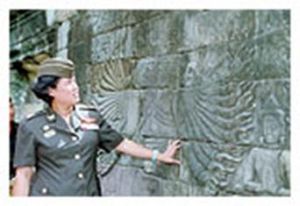 Unfortunately these carvings have been an irresistible magnet for looters in the last few years and this pillage plumbed new depths recently with the boldest and best-organised temple robbery of all time. In all, just under half of the temple’s wall carvings have now been removed but the latest theft was discovered by accident when Thai police stopped a truck carrying no less than 117 heavy stone pieces from a dismantled wall. This has prompted a major crackdown on the plundering of artefacts from the 1,200 ancient temples scattered across the country by both Cambodian and Thai authorities. A visit by Thai Princess Maha Chakri Sirindhorn to Banteay Chhmar has helped to raise awareness of the plight facing these remote Khmer temples and the above picture shows her inspecting one of the bas-reliefs still in place.
Unfortunately these carvings have been an irresistible magnet for looters in the last few years and this pillage plumbed new depths recently with the boldest and best-organised temple robbery of all time. In all, just under half of the temple’s wall carvings have now been removed but the latest theft was discovered by accident when Thai police stopped a truck carrying no less than 117 heavy stone pieces from a dismantled wall. This has prompted a major crackdown on the plundering of artefacts from the 1,200 ancient temples scattered across the country by both Cambodian and Thai authorities. A visit by Thai Princess Maha Chakri Sirindhorn to Banteay Chhmar has helped to raise awareness of the plight facing these remote Khmer temples and the above picture shows her inspecting one of the bas-reliefs still in place. 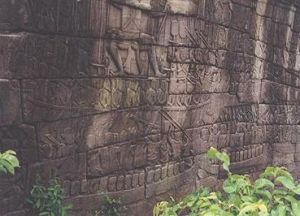 Banteay Chhmar originally covered an area of 2.5 x 2km (in comparison, Angkor Thom is 3km square) and contained the main sandstone temple, a number of other religious structures and a baray (1500 x 700m) to the east of the temple. Lying outside the moat-enclosed main temple’s eastern entrance is an isolated stone rest-house, known as a dharmasala (similar to the one found at Preah Khan in Angkor). A wall measuring 250 x 190 metres surrounds the temple proper, with four gopuras in the middle of each side. Its outer face carries bas-reliefs on three tiers showing alternating military and religious scenes, recalling those of the outer gallery of the Bayon, including battle scenes featuring the Chams (left). Although some parts of the wall have collapsed, the best of the reliefs are south of the gopura on the west wall and include a series of eight colossal standing, multi-armed Lokitesvaras, facing west.
Banteay Chhmar originally covered an area of 2.5 x 2km (in comparison, Angkor Thom is 3km square) and contained the main sandstone temple, a number of other religious structures and a baray (1500 x 700m) to the east of the temple. Lying outside the moat-enclosed main temple’s eastern entrance is an isolated stone rest-house, known as a dharmasala (similar to the one found at Preah Khan in Angkor). A wall measuring 250 x 190 metres surrounds the temple proper, with four gopuras in the middle of each side. Its outer face carries bas-reliefs on three tiers showing alternating military and religious scenes, recalling those of the outer gallery of the Bayon, including battle scenes featuring the Chams (left). Although some parts of the wall have collapsed, the best of the reliefs are south of the gopura on the west wall and include a series of eight colossal standing, multi-armed Lokitesvaras, facing west.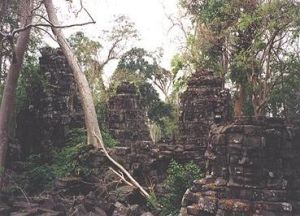 The confusing jumble of ruins that comprises the temple’s central complex gives the visitor no obvious route or path to follow and due to the tangled vegetation the best way of exploring is scrambling over gallery roofs and the large piles of collapsed stones. The long, narrow central sanctuary (170 x 40m) has interconnected galleries, gopuras and towers, both with and without carved faces (again, similar in style to those at the Bayon; pictured right). Near the centre, three face-towers stand in isolation amongst the ruins and undergrowth. To the north, west and south are three separate temples with more faces but most have collapsed and cannot be identified. Close by, a building known as the ‘Hall of Dancers’ houses a fine lintel showing half-human, half-bird apsaras, rishis and Brahma in excellent condition.
The confusing jumble of ruins that comprises the temple’s central complex gives the visitor no obvious route or path to follow and due to the tangled vegetation the best way of exploring is scrambling over gallery roofs and the large piles of collapsed stones. The long, narrow central sanctuary (170 x 40m) has interconnected galleries, gopuras and towers, both with and without carved faces (again, similar in style to those at the Bayon; pictured right). Near the centre, three face-towers stand in isolation amongst the ruins and undergrowth. To the north, west and south are three separate temples with more faces but most have collapsed and cannot be identified. Close by, a building known as the ‘Hall of Dancers’ houses a fine lintel showing half-human, half-bird apsaras, rishis and Brahma in excellent condition.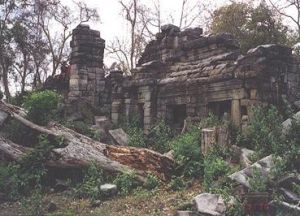 The temple complex lies sixty kilometres north of Sisophon along Route 69 and just thirteen kilometres from the Thai border. From Sisophon, it takes around 2 hours on a motorbike to travel the 43 kilometres to the village of Thmar Puok and then another seventeen kilometres to the south-west corner of the moat surrounding Banteay Chhmar. The road follows the moat around to the east side and a broad causeway, flanked by the baray, signals the entrance to the temple-city. Foreign visitors have so far been few and far between, although the improved security situation in the area will one day make the temple a popular diversion for those taking the overland route from Thailand into Cambodia via Poipet. A recent [2000] visitor to the site, Phalla from Angkor Adventures, confirmed that soldiers act as guides for the few travellers that make it up there and charge a $5 entrance fee. He took the pictures that you see above.
The temple complex lies sixty kilometres north of Sisophon along Route 69 and just thirteen kilometres from the Thai border. From Sisophon, it takes around 2 hours on a motorbike to travel the 43 kilometres to the village of Thmar Puok and then another seventeen kilometres to the south-west corner of the moat surrounding Banteay Chhmar. The road follows the moat around to the east side and a broad causeway, flanked by the baray, signals the entrance to the temple-city. Foreign visitors have so far been few and far between, although the improved security situation in the area will one day make the temple a popular diversion for those taking the overland route from Thailand into Cambodia via Poipet. A recent [2000] visitor to the site, Phalla from Angkor Adventures, confirmed that soldiers act as guides for the few travellers that make it up there and charge a $5 entrance fee. He took the pictures that you see above. 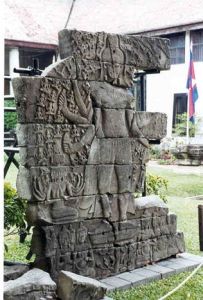
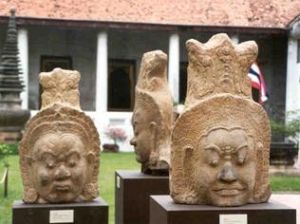
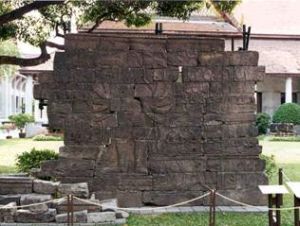
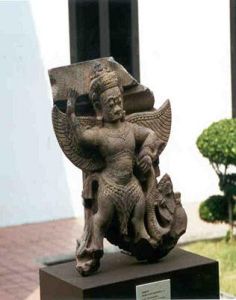
 Mac is still not very well but is still e-mailing strong. In this month’s Globetrotter e-newsletter, he writes about postcards he sent home over the years and a trip he made over twenty years ago to Britain’s Chelsea Pensioners.
Mac is still not very well but is still e-mailing strong. In this month’s Globetrotter e-newsletter, he writes about postcards he sent home over the years and a trip he made over twenty years ago to Britain’s Chelsea Pensioners.